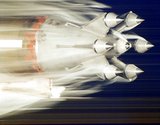PAS 2011: JSF sensors complete Northern Edge exercise
Joint Strike Fighter (JSF) sensors were successfully tested as part of the US Pacific Command's Northern Edge exercise as additional roles for the aircraft become apparent, according to Northrop Grumman.
Speaking at the Paris Air Show, Chuck Brinkman, sector VP and GM for Northrop Grumman's targeting systems division described how the AN/APG-81 active electronically scanned array (AESA) radar and AN/AAQ-37 Distributed Aperture System (DAS) were tested in the Alaska-based exercise on board a BAC1-11 aircraft.
According to Brinkman, the AESA radar was tested with Block 3 development software while the DAS was tested with Block 2 delivery software: 'We have proven the robustness of the radar once again and this is an example in the [JSF] programme of what is going right. It's a shining example,' Brinkman announced.
Making its second appearance in the exercise, the radar demonstrated electronic protection and attack as well as data-linked air and surface tracks. The DAS was used for target tracking, Brinkman added.
'Alaska is a place where you can operate in a very difficult electronic environment and showed how the sensors will perform in that stressing case. Electronic protection was focused on [during the exercise] and we are looking forward to seeing how well we did this year,' he continued. Official data and feedback from US Pacific Command is expected within the next three months.
In addition, Brinkman told Shephard that Northrop Grumman was in talks with the US Missile Defense Agency (MDA) regarding a ballistic missile defence (BMD) capability for JSF. Tests were conducted in 2010 in which DAS was used to detect and track missile rocket launches at distances exceeding 800 miles.
DAS was initially tasked with missile warning, tracking of friendly, unknown and enemy aircraft and general situation awareness capabilities for the pilot. However, Brinkman said the MDA was interested a role for JSF although no further tests have been scheduled.
Finally, Brinkman said he had hoped to use the JSF helmet mounted display system as part of exercise Northern Edge and said the company was actively working with Lockheed Martin and Vision Systems International to solve DAS night vision problems.
Describing potential calls for an alternate helmet solution, Brinkman said: 'I believe the programme will not have to use night vision goggles. In the not too distant future, we hope to use our test aircraft to help get through this problem. The Pilots need the capability that DAS provides.'
More from Digital Battlespace
-
![Babcock nears first customer for Nomad AI translation tool]()
Babcock nears first customer for Nomad AI translation tool
Nomad can provide militaries with real-time intelligence, saving critical time on the battlefield.
-
![AUSA 2025: Israel’s Asio Technologies to supply hundreds of improved Taurus tactical systems]()
AUSA 2025: Israel’s Asio Technologies to supply hundreds of improved Taurus tactical systems
Taurus operates alongside the Israel Defense Forces’ Orion system which supports mission management across tens of thousands of manoeuvring forces, from squad leaders to battalion commanders.
-
![AUSA 2025: Kopin pushes micro-LED plans as China moves faster]()
AUSA 2025: Kopin pushes micro-LED plans as China moves faster
The plan for the new displays follows fresh investment in Kopin’s European facilities by Theon and an order for head-up displays in fielded aircraft, with funding from the US Department of Defense.
-
![AUSA 2025: Persistent Systems to complete its largest order by year’s end]()
AUSA 2025: Persistent Systems to complete its largest order by year’s end
Persistent Systems received its largest ever single order for its MPU5 devices and other systems earlier this month and has already delivered the 50 units to the US Army’s 4th Infantry Division.
-
![Aselsan brings in dozens of companies and systems under the Steel Dome umbrella]()
Aselsan brings in dozens of companies and systems under the Steel Dome umbrella
Turkey has joined the family of countries attempting to establish a multilayered air defence system with government approval in August 2024 for the effort landed by Aselsan. Dubbed Steel Dome, the programme joins Israel’s Iron Dome, the US Golden Dome, India’s Mission Sudarshan Chakra and South Korea’s low-altitude missile defence system.
-
![DSEI 2025: MARSS unveils new agnostic multidomain C4 system]()
DSEI 2025: MARSS unveils new agnostic multidomain C4 system
MARSS’ NiDAR system has been deployed using sensors from static platforms to provide detection and protection for static sights, such as critical infrastructure, ports and military bases.


























